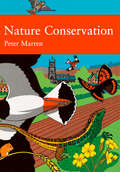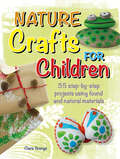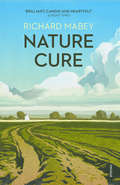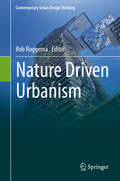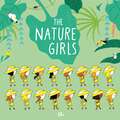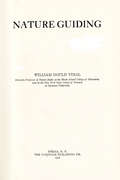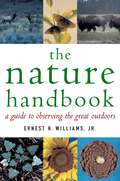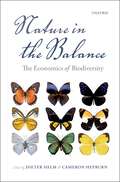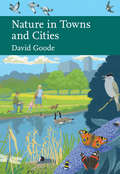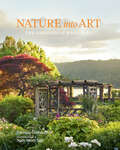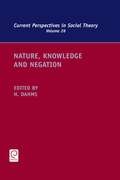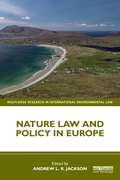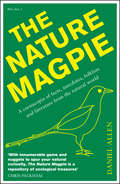- Table View
- List View
Nature, Choice and Social Power
by Erica SchoenbergerWe are at an environmental impasse. Many blame our personal choices about the things we consume and the way we live. This is only part of the problem. Different forms of social power - political, economic and ideological - structure the choices we have available. This book analyses how we make social and environmental history and why we end up where we do. Using case studies from different environmental domains – earth and water, air and fire – Nature, Choice and Social Power examines the form that social power takes and how it can harm the environment and hinder our efforts to act in our own best interests. The case studies challenge conventional wisdoms about why gold is valuable, why the internal combustion engine triumphed, and when and why suburbs sprawled. The book shows how the power of individuals, the power of classes, the power of the market and the power of the state at different times and in different ways were critical to setting us on a path to environmental degradation. It also challenges conventional wisdoms about what we need to do now. Rather than reducing consumption and shrinking from outcomes we don’t want, it proposes growing towards outcomes we do want. We invested massive resources in creating our problems; it will take equally large investments to fix them. Written in a clear and engaging style, the book is underpinned with a political economy framework and addresses how we should understand our responsibility to the environment and to each other as individuals within a large and impersonal system.
Nature Conservation: Concepts and Practice (Environmental Science and Engineering)
by Dan Gafta John R. AkeroydThis book provides a multi-disciplinary coverage of the broad fields of species, community and landscape conservation. The panel of contributors consider a range of topics in vegetation and biodiversity assessment, planning and management of conservation zones and protected areas, together with historical and social/legal issues of the environment and nature conservation. The book celebrates the life’s work of Professor Franco Pedrotti.
Nature Conservation: A Critical Introduction
by Klaus-Dieter HupkeMany things happen in nature reserves that are contradictory at first glance. For example, flower meadows are mown down during maintenance work, even though all the plants growing there are protected. Elsewhere, protected reed beds are burnt down in a fen or the top layer of soil is removed with bulldozers in a dune conservation area. Still other areas are to remain completely untouched by human intervention. The author Klaus-Dieter Hupke shows the different strategies of nature conservation. He also shows that nature conservation is mostly not exactly what the term says in essence: "protection of nature". On the contrary, in Central Europe nature conservation areas are predominantly the relics of old agricultural and thus cultural landscapes. Often, aesthetic aspects of a landscape section are also in the foreground when designating it as a natural monument or nature reserve. Moreover, nature conservation runs the risk of becoming a substitute action and an alibi for a still growing destruction of traditional and near-natural landscape systems in Central Europe as well as globally.The updated second edition now explicitly includes the consequences of climate change for nature conservation and has also incorporated a stronger reference to Austria as well as to the central Alpine region in some places for the relevant readers.
Nature Conservation (Collins New Naturalist Library #91)
by Peter MarrenThis latest volume in the New Naturalist series provides a comprehensive study of wildlife conservation in Britain, concentrating on events in the last 30 years.
Nature Crafts for Children
by Clare YoungsKeep your kids’ boredom at bay with 35 environmentally-friendly ideas they’ll love to make. Designed with the environment in mind, this brilliant collection of craft projects will keep kids entertained for hours. It features decorations, toys, jewellery, gifts, and more, every one of them incorporating natural materials – woodland folk are created from pine cones and seed pods, a length of bark is the base for an animal painting, and a piece of slate is transformed into a pretty brooch or badge. The fun ideas range from bark rubbings for budding artists to herb head flowerpots for junior gardeners and are sure to give kids the creative bug. Best of all, finding the project materials encourages kids to get outside! They can gather shells on the beach to make the shell mice, or collect leaves and twigs on a countryside walk to make a printed fox wall hanging. Even their own garden will become an exciting source of crafty materials.
Nature & Culture: A change empowered by joy!
by The Council for Eco-PhilosophyDalai Lama (2000) believes that seeking happiness "lies in our nature”: The desire or need to be happy knows no bounds. It is something that lies in our nature. As such, it needs no grounds and it is justified by the simple fact that it is something we rightly want out of our nature. One has also asked if happiness is as important in all cultures. The answer is that happiness is at the top of the wish-list in every country; It is more important than wealth and to come to heaven, and as important as love (Diener and Biswas-Diener, 2008)...what makes us richer has been costly. The wealth, or what has been the prerequisite for wealth, has reduced a quieter life, close and stable relationships, we are moving apart. A materialistic lifestyle has a negative connection with happiness (Hellevik, 2003). NEF (2016) has calculated values on Happy Planet Index for 140 countries. Highest ranks Costa Rica and a number of other countries in Latin America. The population of Costa Rica has high values for happiness and longevity, and they have low values of ecological footprints. Norway has very high values of happiness and longevity, but also of footprints. In total, Norway is ranked twelfth and therefore highest among European countries, but closely followed by Albania. The United Kingdom is at thirty-fourth place, Canada number eighty-five and the United States number 108.
Nature, Culture and Gender: Re-reading the folktale
by P. Mary PorselviFolktales in India have been told, heard, read and celebrated for many centuries. In breaking new ground, Indian folktales have been reread and examined in the light of the Mother Earth discourse as it manifests in the lifeworlds of women, nature and language. The book introduces ecofeminist criticism and situates it within an innovative folktale typology to connect women and environment through folklore. The book proposes an innovative paradigm inspired by the beehive to analyze motifs, relationships, concerns, worldviews and consciousness of indigenous women and men who live close to nature as well as other socially marginalized groups. In the current global context fraught with challenges for ecology and hopes for sustainable development, this book with its interdisciplinary approach will interest scholars and researchers of literature, environmental studies, gender studies and cultural anthropology.
Nature, Culture and Gender: Re-reading the folktale
by P. Mary PorselviFolktales in India have been told, heard, read and celebrated for many centuries. In breaking new ground, Indian folktales have been reread and examined in the light of the Mother Earth discourse as it manifests in the lifeworlds of women, nature and language. The book introduces ecofeminist criticism and situates it within an innovative folktale typology to connect women and environment through folklore. The book proposes an innovative paradigm inspired by the beehive to analyze motifs, relationships, concerns, worldviews and consciousness of indigenous women and men who live close to nature as well as other socially marginalized groups. In the current global context fraught with challenges for ecology and hopes for sustainable development, this book with its interdisciplinary approach will interest scholars and researchers of literature, environmental studies, gender studies and cultural anthropology.
Nature Cure
by Richard MabeyIn the last year of the old millennium, Richard Mabey, Britain's foremost nature writer, fell into a severe depression. The natural world – which since childhood had been a source of joy and inspiration for him – became meaningless. Then, cared for by friends, he moved to East Anglia and he started to write again. Having left the cosseting woods of the Chiltern hills for the open flatlands of Norfolk, Richard Mabey found exhilaration in discovering a whole new landscape and gained fresh insights into our place in nature. Structured as intricately as a novel, a joy to read, truthful, exquisite and questing, Nature Cure is a book of hope, not just for individuals, but for our species.
Nature Driven Urbanism (Contemporary Urban Design Thinking)
by Rob RoggemaThis book discusses the way that a nature-driven approach to urbanism can be applied at each of the urban scales; architectural design, urban design of neighborhoods, city planning and landscape architecture, and at the city and regional scales. At all levels nature-driven approaches to design and planning add to the quality of the built structure and furthermore to the quality of life experienced by people living in these environments. To include nature and greening to built structures is a good starting point and can add much value. The chapter authors have fiducia in giving nature a fundamental role as an integrated network in city design, or to make nature the entrance point of the design process, and base the design on the needs and qualities of nature itself. The highest existence of nature is a permanent ecosystem which endures stressors and circumstances for a prolonged period. In an urban context this is not always possible and temporality is an interesting concept explored when nature is not a permanent feature. The ecological contribution to the environment, and indirect dispersion of species, from a temporary location will, overall add biodiversity to the entire system.
Nature, Environment and Poetry: Ecocriticism and the poetics of Seamus Heaney and Ted Hughes (Routledge Environmental Humanities)
by Susanna LidströmThe environmental challenges facing humanity in the twenty-first century are not only acute and grave, they are also unprecedented in kind, complexity and scope. Nonetheless, or therefore, the political response to problems such as climate change, biodiversity loss and widespread pollution continues to fall short. To address these challenges it seems clear that we need new ways of thinking about the relationship between humans and nature, local and global, and past, present and future. One place to look for such new ideas is in poetry, designed to contain multiple levels of meaning at once, challenge the imagination, and evoke responses that are based on something more than scientific consensus and rationale. This ecocritical book traces the environmental sensibilities of two Anglophone poets; Nobel Prize-winner Seamus Heaney (1939-2013), and British Poet Laureate Ted Hughes (1930-1998). Drawing on recent and multifarious developments in ecocritical theory, it examines how Hughes's and Heaney's respective poetics interact with late twentieth century developments in environmental thought, focusing in particular on ideas about ecology and environment in relation to religion, time, technology, colonialism, semiotics, and globalisation. This book is aimed at students of literature and environment, the relationship between poetry and environmental humanities, and the poetry of Ted Hughes or Seamus Heaney
Nature, Environment and Poetry: Ecocriticism and the poetics of Seamus Heaney and Ted Hughes (Routledge Environmental Humanities)
by Susanna LidströmThe environmental challenges facing humanity in the twenty-first century are not only acute and grave, they are also unprecedented in kind, complexity and scope. Nonetheless, or therefore, the political response to problems such as climate change, biodiversity loss and widespread pollution continues to fall short. To address these challenges it seems clear that we need new ways of thinking about the relationship between humans and nature, local and global, and past, present and future. One place to look for such new ideas is in poetry, designed to contain multiple levels of meaning at once, challenge the imagination, and evoke responses that are based on something more than scientific consensus and rationale. This ecocritical book traces the environmental sensibilities of two Anglophone poets; Nobel Prize-winner Seamus Heaney (1939-2013), and British Poet Laureate Ted Hughes (1930-1998). Drawing on recent and multifarious developments in ecocritical theory, it examines how Hughes's and Heaney's respective poetics interact with late twentieth century developments in environmental thought, focusing in particular on ideas about ecology and environment in relation to religion, time, technology, colonialism, semiotics, and globalisation. This book is aimed at students of literature and environment, the relationship between poetry and environmental humanities, and the poetry of Ted Hughes or Seamus Heaney
Nature for Sale: The Commons versus Commodities
by Giovanna RicoveriUncovering the rich heritage of common ownership which existed before the dominance of capitalist property relations, Giovanna Ricoveri argues that the subsistence commons of the past can be reinvented today to provide an alternative to the current destructive economic order. *BR**BR*Ricoveri outlines the distinct features of common ownership as it has existed in history through cooperatives, sustainable use of natural resources and direct democracy. In doing so, she shows how it is possible to provide goods and services which are not commodities exchanged on the capitalistic market, something still demonstrated today in village communities across the global South.*BR**BR*Tracing the erosion of the commons from the European enclosures at the dawn of the Industrial Revolution to the new enclosures of modern capitalism, the book concludes by arguing that a new commons is needed today. It will be essential reading for activists as well as students and academics in history, politics, economics and development studies.
Nature for Sale: The Commons versus Commodities
by Giovanna RicoveriUncovering the rich heritage of common ownership which existed before the dominance of capitalist property relations, Giovanna Ricoveri argues that the subsistence commons of the past can be reinvented today to provide an alternative to the current destructive economic order. *BR**BR*Ricoveri outlines the distinct features of common ownership as it has existed in history through cooperatives, sustainable use of natural resources and direct democracy. In doing so, she shows how it is possible to provide goods and services which are not commodities exchanged on the capitalistic market, something still demonstrated today in village communities across the global South.*BR**BR*Tracing the erosion of the commons from the European enclosures at the dawn of the Industrial Revolution to the new enclosures of modern capitalism, the book concludes by arguing that a new commons is needed today. It will be essential reading for activists as well as students and academics in history, politics, economics and development studies.
The Nature Girls
by AKI Delphine MachWe're Nature Girls! We must explore. We pack our bags, we're out the door . . .The bold Nature Girls are ready for whatever nature throws at them! Join them as they pack their bags and start their journey, exploring natural habitats around the world. They swim in the sea, explore the desert, discover the harsh arctic tundra and more. There's so much to discover about the natural world, when you join this bright group of girls.The Nature Girls is an adorable rhyming picture book with stunning illustrations and a summary spread of fun nature facts at the back, from author/illustrator, Aki.
Nature Guiding
by William Gould VinalNature Guiding is the science of inculcating nature enthusiasm, nature principles, and nature facts into the spirit of individuals. "Doing" nature-study means observing, wondering, and solving problems. It could include collecting, building, measuring, painting, planning, writing, touching, experimenting or any of a wide range of other activities. Most importantly, it allows children to be "original investigators."This book is intended as a resource for teachers and students engaged in nature study at summer camps and in schools. William Gould Vinal believed that the teacher of nature study should be "in sympathy with the simple life and the country way," that the nature study should emphasize observation of the interactions of plants and animals in their environment, and not be reduced to matters of taxonomy and anatomy. In Nature Guiding, he offers advice to camp counselors and school teachers on incorporating nature study into everyday activities, as well as suggestions for parents and others about using visits to state and national parks to teach nature lore.
The Nature Handbook: A Guide to Observing the Great Outdoors
by Ernest H. WilliamsNature is full of fascinating stories, stories that attract our attention at a young age and keep us amazed throughout our entire lives. The need to understand nature draws us back to its simple beauty again and again, yet underneath this simplicity lies a complex web of associations and patterns. The Nature Handbook does what no other field guide does: explores and explains nature through these connecting patterns, revealing them to the many different types of nature lovers. All naturalists-- from birders to gardeners, hikers to environmentalists, wildflower enthusiasts to butterfliers-- will appreciate the different approach of the Handbook, even those whose interest in the natural world is just beginning to develop. Naturalists who are already well versed in one group of organisms--birders, for example--will find new explanations and patterns for their favorite group, as well as new patterns all around them that they had previously overlooked. Observations in the Handbook are arranged in the three main sections of plants, animals, and habitats. These sections are then connected through discussions of the relationship of size and shape, adaptations, distribution patterns, behavior, and diversity of life. Since the emphasis is on patterns rather than individual species, each chapter has cross-references to related topics. For example, tree-related topics such as leaf shape, treelines, and fall colors, are all discussed in different chapters even though they are related. Leaf shape is associated with trees as organisms, and therefore is in Chapter 2: Trees; treelines are most associated with mountains, so their description is in Chapter 8: Mountains; fall colors apply more broadly to forests than to individual trees, and they are discussed in Chapter 9,Forests. Approximately 500 color photographs help make the more than 200 patterns apparent and recognizable for readers, and each pattern is accompanied by a detailed description and a brief list of sources. The book is designed to invite browsing, and readers will gain a rich ecological perspective and insight. Curiosity about the world around us is a basis for human learning; The Nature Handbook serves to aid all nature lovers in their quest for understanding the many stories that our living world provides.
The Nature Handbook: A Guide to Observing the Great Outdoors
by Ernest H. WilliamsNature is full of fascinating stories, stories that attract our attention at a young age and keep us amazed throughout our entire lives. The need to understand nature draws us back to its simple beauty again and again, yet underneath this simplicity lies a complex web of associations and patterns. The Nature Handbook does what no other field guide does: explores and explains nature through these connecting patterns, revealing them to the many different types of nature lovers. All naturalists-- from birders to gardeners, hikers to environmentalists, wildflower enthusiasts to butterfliers-- will appreciate the different approach of the Handbook, even those whose interest in the natural world is just beginning to develop. Naturalists who are already well versed in one group of organisms--birders, for example--will find new explanations and patterns for their favorite group, as well as new patterns all around them that they had previously overlooked. Observations in the Handbook are arranged in the three main sections of plants, animals, and habitats. These sections are then connected through discussions of the relationship of size and shape, adaptations, distribution patterns, behavior, and diversity of life. Since the emphasis is on patterns rather than individual species, each chapter has cross-references to related topics. For example, tree-related topics such as leaf shape, treelines, and fall colors, are all discussed in different chapters even though they are related. Leaf shape is associated with trees as organisms, and therefore is in Chapter 2: Trees; treelines are most associated with mountains, so their description is in Chapter 8: Mountains; fall colors apply more broadly to forests than to individual trees, and they are discussed in Chapter 9,Forests. Approximately 500 color photographs help make the more than 200 patterns apparent and recognizable for readers, and each pattern is accompanied by a detailed description and a brief list of sources. The book is designed to invite browsing, and readers will gain a rich ecological perspective and insight. Curiosity about the world around us is a basis for human learning; The Nature Handbook serves to aid all nature lovers in their quest for understanding the many stories that our living world provides.
Nature In The Balance: The Economics Of Biodiversity
by Dieter Helm Cameron HepburnThis book sets out the building blocks of an economic approach to biodiversity, and in particular brings together conceptual and empirical work on valuation, international agreements, the policy instruments, and the institutions. The objective is to provide a comprehensive overview of the issues and evidence, and to suggest how this very urgent problem should be addressed. Whilst there has been an enormous growth and research focus on climate change, less attention has been paid to biodiversity. This collection of high-quality chapters addresses the economic issues involved in biodiversity protection. This book focuses on the economics, but incorporates the underpinning science and philosophy, combining the application of a number of theoretical ideas with a series of policy cases. The authors are drawn from leading scholars in their specific areas of economics, philosophy, and conservation biology.
Nature in Towns and Cities (Collins New Naturalist Library #127)
by David GoodeThe latest in the New Naturalist series documents the parks and green spaces unique to Britain's cities – and the wildlife that has flourished in these habitats.
Nature into Art: The Gardens of Wave Hill
by Thomas ChristopherWave Hill is an iconic public garden located in the Bronx. In this lushly-illustrated, inspirational guide, gardeners will discover the plants and designs that define the garden and learn how to recreate the aesthetic sensibilities at home.
Nature, Knowledge and Negation (Current Perspectives in Social Theory #26)
by Professor Harry F. DahmsThe first emphasis of the volume is on developments in the social theory of environmental issues, the environment, and the environmental crisis. The second emphasis is on the increasingly questionable possibility of shared knowledge at a time of increasing fragmentation of common frameworks, distraction from key issues, and dilution of the idea of objectivity. The thematic emphasis on environmental challenges and issues, includes one contribution on climate change, the resource crunch, and the global growth Imperative, along with critical responses by other experts in this field, and two contributions on the development of planetarian accountancy, and the ubiquity of risk in consumer societies. Further contributions address issues relating to the dialectic of selfhood, the aftermath of postmodernism, limitations inherent to feminist perspectives, the project of public sociology, the fortieth anniversary of Jurgen Habermas' classic, Knowledge and Human Interests, and the need for critical theory to rely on social research.
Nature Law and Policy in Europe (Routledge Research in International Environmental Law)
by Andrew L. R. JacksonThis volume considers current and future challenges for nature law and policy in Europe. Following the Fitness Check evaluation of the Birds and Habitats Directives, in 2017 the EU adopted an Action Plan for nature, people and the economy to rapidly improve the Directives’ implementation and accelerate progress towards the EU's biodiversity targets for 2020. More recently, the EU has adopted a Biodiversity Strategy for 2030 and proposed an EU Nature Restoration Law. This book makes a timely contribution by examining the current state of play in light of recent and historical developments, as well as the post-2020 nature law and policy landscape. While evidence suggests that Natura 2000 and the Habitats and Birds Directives have delivered conservation benefits for wildlife in Europe, biodiversity loss continues apace. The book reviews the requirements for an effective international nature conservation system, with reference to the Birds and Habitats Directives. It examines regulatory regimes, current legal issues in the fields of site protection and species protection, the protection of areas outside Natura 2000, recent developments in the EU and the UK, including the implications of Brexit, agriculture and nature conservation, litigation, science and access to justice. Written by leading experts in the field, from a range of stakeholder groups, the volume draws on diverse experiences as well as providing interdisciplinary perspectives. This volume will be essential reading for students, scholars, practitioners, NGOs and policy-makers interested in European environmental policy and law, including for example lawyers, ecologists, environmental scientists, political scientists, natural resource managers, planners and civil servants.
Nature Law and Policy in Europe (Routledge Research in International Environmental Law)
This volume considers current and future challenges for nature law and policy in Europe. Following the Fitness Check evaluation of the Birds and Habitats Directives, in 2017 the EU adopted an Action Plan for nature, people and the economy to rapidly improve the Directives’ implementation and accelerate progress towards the EU's biodiversity targets for 2020. More recently, the EU has adopted a Biodiversity Strategy for 2030 and proposed an EU Nature Restoration Law. This book makes a timely contribution by examining the current state of play in light of recent and historical developments, as well as the post-2020 nature law and policy landscape. While evidence suggests that Natura 2000 and the Habitats and Birds Directives have delivered conservation benefits for wildlife in Europe, biodiversity loss continues apace. The book reviews the requirements for an effective international nature conservation system, with reference to the Birds and Habitats Directives. It examines regulatory regimes, current legal issues in the fields of site protection and species protection, the protection of areas outside Natura 2000, recent developments in the EU and the UK, including the implications of Brexit, agriculture and nature conservation, litigation, science and access to justice. Written by leading experts in the field, from a range of stakeholder groups, the volume draws on diverse experiences as well as providing interdisciplinary perspectives. This volume will be essential reading for students, scholars, practitioners, NGOs and policy-makers interested in European environmental policy and law, including for example lawyers, ecologists, environmental scientists, political scientists, natural resource managers, planners and civil servants.
The Nature Magpie: A Cornucopia of Facts, Anecdotes, Folklore and Literature from the Natural World (Magpie Ser.)
by Daniel AllenA collection of anecdotes, facts, figures, folklore and literature, The Nature Magpie is a veritable treasure trove of humanity’s thoughts and feelings about nature. With acclaimed nature writer Daniel Allen as your guide, join naturalists, novelists and poets as they explore the most isolated parts of the planet, choose your side – pineapple or durian – in the great 'king of fruits' debate and discover which plants can be used to predict the weather. Meet the roadkill connoisseurs, learn to dance the Hippopotamus Polka, find out the likelihood of sharing your name with a hurricane – and much more.



